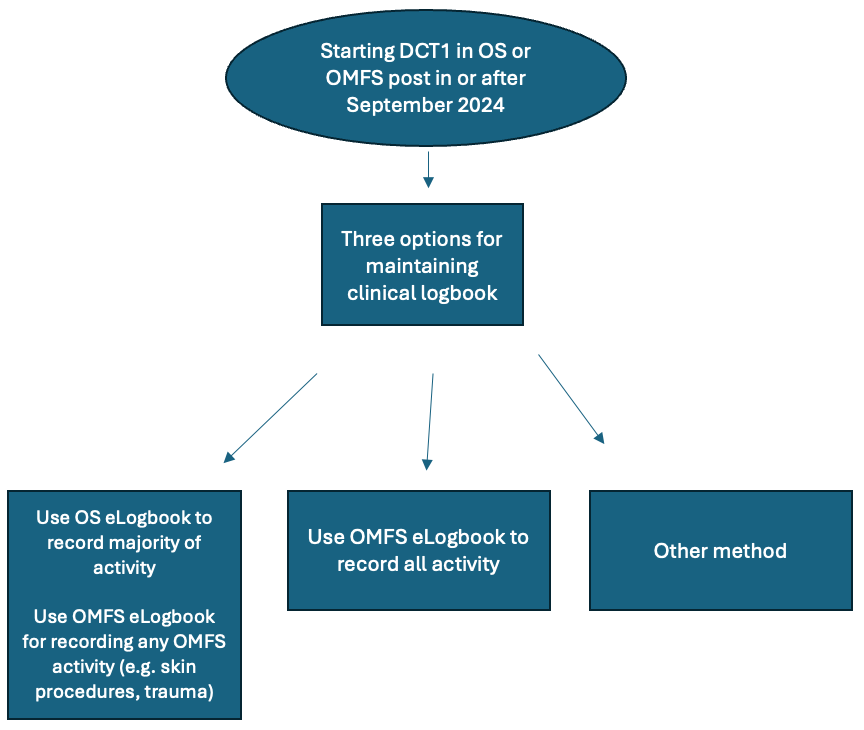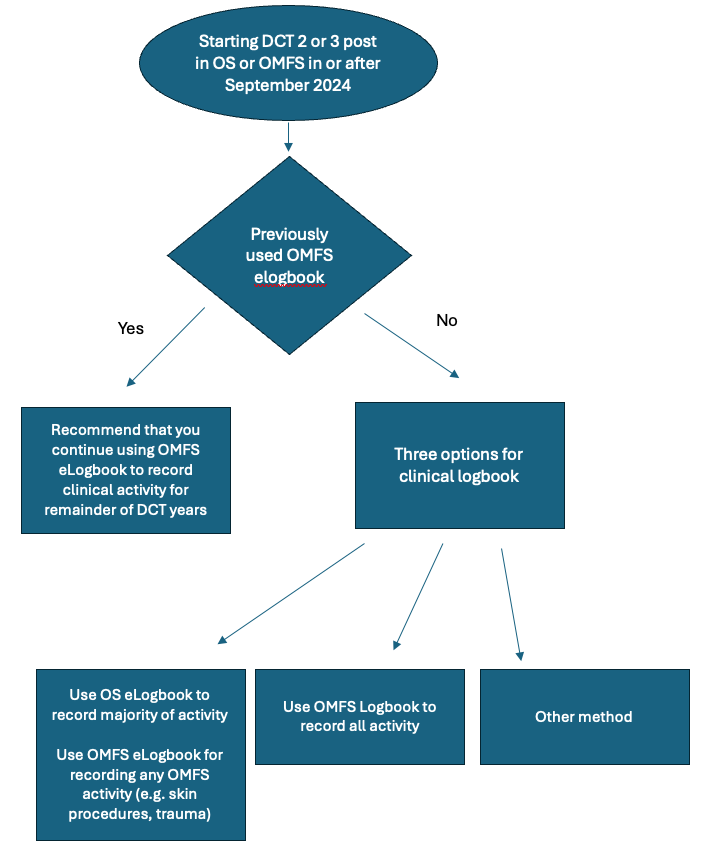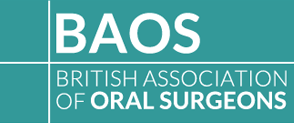e Logbook
Information for Users
The British Association of Oral Surgeons (BAOS) has funded the development and release of an Oral Surgery specific eLogbook. This is now live and available on the eLogbook.org website.
Dentists working in Oral Surgery currently use the Oral and Maxillofacial Surgery eLogbook to record their surgical activity.
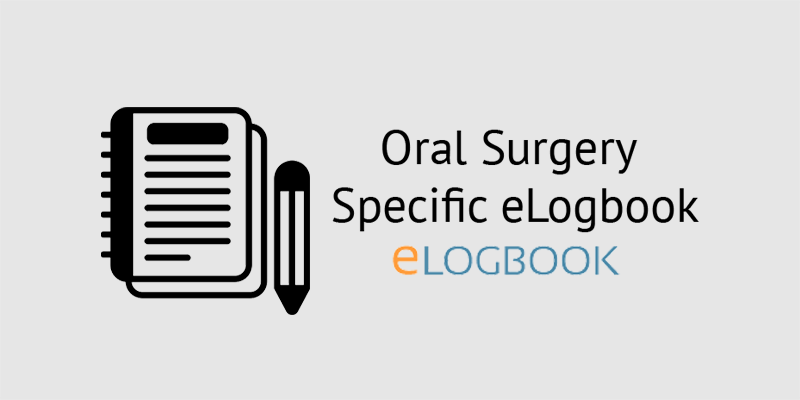
Why has an Oral Surgery eLogbook been developed and introduced?
Using the OMFS eLogbook has several drawbacks for Oral Surgery:
1. Full functionalities of eLogbook cannot be utilised;
Oral Surgery is an individual training programme within the OMFS logbook and this means that the full functionalities of elogbook cannot be utilised – there are several reports such as regional activity and peer analysis reports which cannot be used as intended to enhance oral surgery training.
2. There are 1,244 operation/procedure codes in the OMFS eLogbook;
Approximately 300 of these procedures are within the scope of Oral Surgery but many are duplicates or there is ambiguity about how to record some procedures. As a result, recording of oral surgery procedures is not consistent and therefore the reporting is not robust.
3. The SAC Consolidation report is structured for OMFS;
This is the report intended to be scrutinised at a specialty trainee ARCPs. Currently this report is structured for OMFS Specialty Training and largely not relevant for Oral Surgery.
Who should use the Oral Surgery eLogbook?
Anyone can use any logbook available on eLogbook. Specialty Trainees who are currently using the OMFS logbook should continue using the OMFS logbook until the end of their specialty training. Those starting specialty training from September 2024 onwards should start using the Oral Surgery eLogbook. For more advice on logbooks for Specialty and Dental Core Training please see the sections on Specialty Training and Dental Core Training.
How do I start using the Oral Surgery eLogbook?
You can access the Oral Surgery eLogbook by using the same login for the eLogbook if you are already an existing user. New users can register for free. To change your default logbook to ‘Oral Surgery’ simply head to the ‘my details’ section of the Administration part of eLogbook and change your default specialty to Oral Surgery.
I work in an OMFS department can I still use the OMFS logbook?
Yes, you can continue to use the OMFS logbook. You may decide to use the Oral Surgery eLogbook to record Oral Surgery activity and the OMFS eLogbook to record OMFS specific activity. It is not possible to merge the two logbooks as they use different procedure codes. We would suggest that you make your default logbook the logbook you will use most. When you want to use the OMFS logbook you can select OMFS from the dropdown menu at the top of the page when adding operations or generating reports. Do not log an oral surgery procedure in both the Oral Surgery logbook and the OMFS logbook. The most important thing is that you are consistent with the way you are recording your activity.
How do reports work?
1. Validation worksheets can be generated from the ‘browse operations’ section of the eLogbook. This will contain any procedures you have recorded in either the Oral Surgery or the OMFS logbooks and you can have this manually signed off.
2. Standard consolidation reports can be generated for individual specialties or pan-specialty in the ‘reports’ section of the eLogbook.
3. Operation group consolidation reports can only be generated per specialty.
4. SAC indicative group consolidation report – the report used for Specialty Training – can only be generated per specialty. If you are recording OMFS activity in the OMFS eLogbook and Oral Surgery data in the Oral Surgery eLogbook then you will have to generate separate consolidation reports.
Why should I use the Oral Surgery eLogbook?
If you provide oral surgery, the Oral Surgery Logbook provides a clear and consistent way of recording oral surgery activity that can be used as one piece of evidence to monitor and demonstrate progression in training and applications for specialty listing. It is the only logbook endorsed by the Oral Surgery Specialty Advisory Committee (SAC) for trainees working to the new Oral Surgery Curriculum in the UK.
What is different about the Oral Surgery eLogbook?
The Oral Surgery logbook has a shorter, rationalised list of procedures which aims to improve consistency in surgical activity reporting and the robustness of reports.
It is now much easier to find the procedure you are looking for. In some instances, the level of detail about certain procedures has been removed to reduce confusion. We have ensured that the most necessary information has been maintained.
There is an improved and easier method of logging multiple extractions and clearances.
There are new specialty specific fields to providing an opportunity to record information on the type of anaesthetic as well as social and medical complexity.
There are now codes to allow you to include non-surgical activity such as medical management of orofacial pain, oral mucosal disease, salivary gland conditions and jawbone conditions.
When some procedures are selected additional fields may appear with supervision level drop downs. These are known as ‘procedure parts’ and these have been added to allow the recording of specific parts of procedures, carried out in more than one procedure. This has been adopted mainly for the dental implantology and grafting procedures with the possibility of being scaled up for other procedures in the future.
What is not different about the Oral Surgery eLogbook?
Although it is a separate logbook it still part of eLogbook and therefore there are no major changes in the usability. You do not need to create a new eLogbook account.
Can the operations in my OMFS eLogbook be transferred over to the Oral Surgery eLogbook?
No, this is not possible because the two logbooks use different procedure codes. You could do this yourself but if you have been using the OMFS logbook for some time, it will take a long time and you would need your clinical supervisors to re-validate procedures. This is not recommended. If you start using the Oral Surgery logbook, the procedures you have recorded in the OMFS eLogbook will remain on the system and you will be able to generate reports on this activity at any time.
I am a Clinical Supervisor / Educational Supervisor for Oral Surgery Specialty or Dental Core Training, do I need to do anything to validate my trainees’ procedures?
No, you will be able to validate your trainees’ procedures regardless of your default specialty.
I am a Training Programme Director for Oral Surgery Specialty Training, do I need to do anything?
Yes, please change your default specialty to Oral Surgery.
Who do I contact if I have any questions?
Any clinical questions – email: OralSurgery@elogbook.org
Any technical problems – email: Helpdesk@elogbook.org
Oral Surgery eLogbook – Further Information
Recording Clearances and Multiple Extractions
The Oral Surgery eLogbook makes recording of multiple extractions and clearances easy and robust. In Oral Surgery multiple teeth are often removed in one episode of treatment.
Instead of having to input multiple individual extractions for a patient you can now enter the number of teeth non-surgically or surgically extracted for one treatment session. If you select a clearance code or the multiple extraction code, a set of additional codes will appear.

You should enter the number of each procedure for each supervision code. If you have not done something – leave the field showing ‘0’. There will also be fields for the surgical extractions of impacted and non-impacted permanent teeth, supernumerary teeth and primary teeth.
These counts will feed into the SAC consolidation report and be added to any surgical or non-surgical extractions recorded individually.
Dental Implantology and Grafting
It is recognised that there are a number of parts to implantology and grafting procedures that are carried out similarly in different implantology and grafting procedures. For example, guided bone regeneration with a resorbable membrane can be carried out during an implant placement or as a separate staged ridge augmentation procedure. As another example, the harvest of an autogenous block graft (e.g. ramus) can be carried out prior to the fixation of an onlay graft for ridge augmentation or prior to a sinus augmentation. Several high-level overarching procedure codes have been included in the Oral Surgery logbook. When you select the procedure code several procedure parts will appear for you to enter the supervision level for each part of the procedure. If a procedure part has not been carried out as part of a procedure, then simply leave the relevant field blank. The following procedure parts have been identified.
- Flap or recipient site preparation (flap, periosteal release, cortical perforations etc)
- Osteotomy Preparation
- Non-surgical extraction permanent tooth
- Surgical extraction non-impacted permanent tooth
- Surgical extraction of impacted tooth
- Implant placement (unguided)
- Implant placement (partially guided -static)
- Implant placement (fully guided – static)
- Implant placement (dynamic navigation)
- Lateral window osteotomy
- Membrane elevation
- Harvest of autogenous block
- Harvest of autogenous bone chips
- Fixation of block (onlay)
- Fixation of block (shell technique)
- Placement of xenograft/allograft/alloplast particulate
- Placement of resorbable membrane (no fixation)
- Placement resorbable membrane (with fixation)
- Placement of non-resorbable membrane (no fixation)
- Placement of non-resorbable membrane (with fixation)
- Harvest of autogenous soft tissue graft
- Placement suturing of soft tissue graft or biomaterial
- Placement of PRF/PRP or similar
- Wound closure
- Removal of membrane
- Removal of fixation screw(s)
Oral Surgery Specialty Specific Fields
You will notice some new fields in the ‘add an operation’ page. Options to add the type of anaesthetic have been added, sedation recording has been improved and detail about medical and social related surgical work-up have been included to capture this important part of the workload.
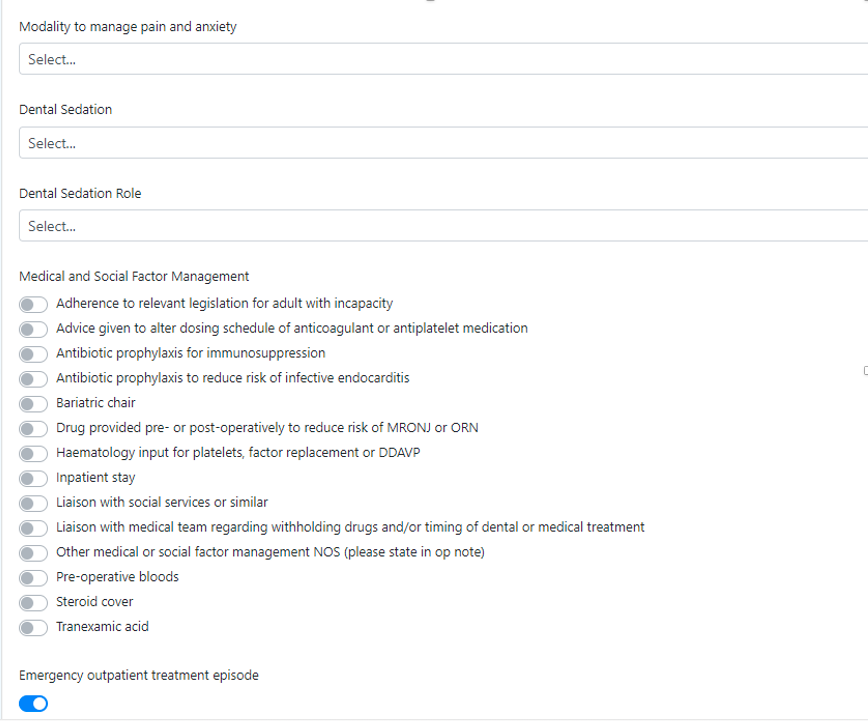
Non-Surgical Activity
The SAC assessment strategy proposes that 40 non-surgical cases are recorded on the elogbook. This will need to be recorded in the elogbook as an ‘operation’ – as it is a surgical logbook. This activity will be presented on the SAC consolidation logbook. Five codes have been added to the logbook to facilitate capturing this activity.
- Orofacial Pain
- This includes both the diagnosis, medical and psychosocial management steps carried out for different orofacial pain conditions.
- Oral Mucosal Disease
- This includes the medical management of immune mediated conditions or the monitoring oral epithelial dysplasia.
- Salivary Gland Disease
- This includes the diagnostic and treatment planning steps of different salivary gland conditions.
- Jaw Bone Disease (e.g. MRONJ)
- This includes the diagnostics planning, conservative management of MRONJ or the medical management of ORN.
- Other Non-Surgical Activity NOS
SAC Consolidation Report
The SAC consolidation report has been designed specifically for Oral Surgery Specialty Training. Before each ARCP trainees should upload two SAC consolidation reports in PDF to their portfolio on ISCP under ‘miscellaneous’:
- SAC consolidation report for the training period since the last ARCP
- SAC consolidation report including activity from the start of their training to the current date.
Make sure that your eLogbook and ISCP have been linked as ARCP panel members should also be able to view your eLogbook on ISCP however the link has had a history of failing and that is why we recommend that PDFs of the SAC consolidation reports are uploaded to ISCP.
Oral Surgery Specialty Trainees – eLogbook
Throughout Oral Surgery (OS) Specialty Training you must hold and maintain a clinical logbook. You should use eLogbook to do this and upload SAC consolidation reports to your portfolio on ISCP prior to every ARCP. You should make sure that your ISCP account is linked to your eLogbook account. The ARCP panel should also be able to view your eLogbook on ISCP however PDFs of your SAC consolidation reports uploaded to your ISCP are expected in the event that the link between the two system breaks. You are expected to upload an SAC consolidation report for the period of training since your last ARCP (e.g. ST2, ST3) and an SAC consolidation report covering your entire training to date. For advice on what eLogbook to use please see below.
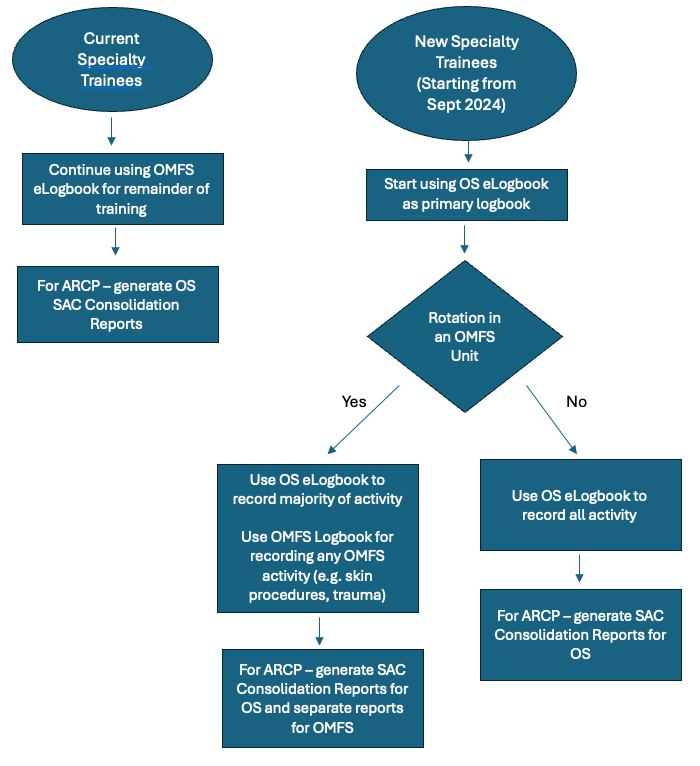
Advice on choice of logbooks for Dental Core Trainees
Keeping a clinical activity log is a requirement for Review of Competency Progression (RCP) for Dental Core Training (DCT) in England, Wales and Northern Ireland. Keeping a clinical activity log is not a requirement for DCT in Scotland although it is advised you keep one for your own records. A validated clinical logbook is also required in the self-assessment processes of National Recruitment for Oral Surgery (OS) Specialty Training and Oral and Maxillofacial Surgery Specialty Training (OMFS).
eLogbook is a database commonly used by dental and surgical core and speciality trainees. The type of logbook/database that you should use to record your clinical activity is not stipulated for DCT. The figures in this document will hopefully be useful when you are deciding how you will record your clinical activity, particularly for those who are working in an OS or OMFS department.
The most important thing to consider is that you should be consistent with the method you use to record clinical activity. You may want to consider your future career aspirations when deciding what logbook to use as your primary logbook.
